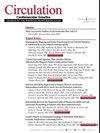Four-Generation Family With Ebstein Anomaly Highlights Future Challenges in Congenital Heart Disease Genetics.
引用次数: 0
Abstract
Mercer et al1 describe a family in which a missense variant in Filamin A ( FLNA ) segregates with Ebstein anomaly. This is a syndromal form of congenital heart disease (CHD) in that affected individuals have craniofacial and musculoskeletal anomalies, as well as keloid scarring and oligodontia. Clinically, affected family members had no apparent neurological involvement, although cranial imaging was not reported. Overall, the phenotype is clearly in a continuum with other FLNA -associated disorders including otopalatodigital syndrome (OPD1 and OPD2) and Melnick–Needles syndrome. However, this represents a new addition to the stable phenotypes linked to FLNA , with the cardiac features being particularly noteworthy. See Article by Mercer et al Such families are a unique resource in expanding our knowledge of causal genes and mechanisms in CHD. The unfolding of this story (some of the family had previously been screened for NKX2-5 and MYH7 mutations in a previous era) over some 25 years, and 4 generations are testament to the persistence of the authors, as well as the effectiveness of modern sequencing technology. It also illustrates the power of the phenotype to illuminate the genotype. Previously, FLNA had been associated with cardiac valvular disease (not including Ebstein anomaly) …Ebstein异常的四代家族突出了先天性心脏病遗传学未来的挑战。
本文章由计算机程序翻译,如有差异,请以英文原文为准。
求助全文
约1分钟内获得全文
求助全文
来源期刊

Circulation: Cardiovascular Genetics
CARDIAC & CARDIOVASCULAR SYSTEMS-GENETICS & HEREDITY
自引率
0.00%
发文量
0
审稿时长
6-12 weeks
期刊介绍:
Circulation: Genomic and Precision Medicine considers all types of original research articles, including studies conducted in human subjects, laboratory animals, in vitro, and in silico. Articles may include investigations of: clinical genetics as applied to the diagnosis and management of monogenic or oligogenic cardiovascular disorders; the molecular basis of complex cardiovascular disorders, including genome-wide association studies, exome and genome sequencing-based association studies, coding variant association studies, genetic linkage studies, epigenomics, transcriptomics, proteomics, metabolomics, and metagenomics; integration of electronic health record data or patient-generated data with any of the aforementioned approaches, including phenome-wide association studies, or with environmental or lifestyle factors; pharmacogenomics; regulation of gene expression; gene therapy and therapeutic genomic editing; systems biology approaches to the diagnosis and management of cardiovascular disorders; novel methods to perform any of the aforementioned studies; and novel applications of precision medicine. Above all, we seek studies with relevance to human cardiovascular biology and disease.
 求助内容:
求助内容: 应助结果提醒方式:
应助结果提醒方式:


